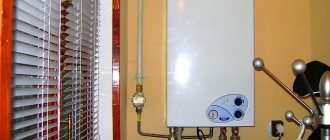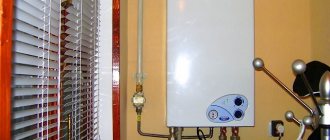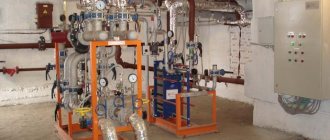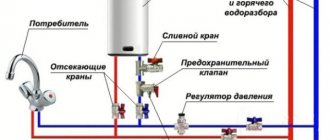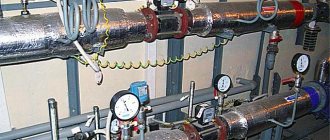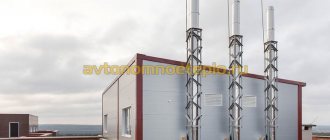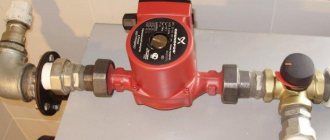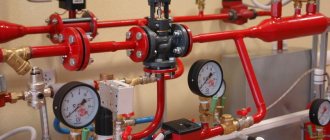Heating is one of the most important communications in an apartment. This system is necessary for heating the home during the cold season.
Previously, apartments were heated using a central heating system (CHS). But today many are switching to “autonomy”.
Read more about how to make individual heating in an apartment building further in the article.
Why do residents refuse central heating?
There are a number of reasons for this:
- unjustified heating costs;
- poor-quality heating of the apartment during the cold period;
- improper heat distribution (especially for corner apartments and rooms located on the ground floor);
- dependence on the established timing of the heating season (cold in autumn and hot in spring);
- inability to maintain the desired temperature at any time.
Judging by the reviews, those who abandoned the central heating system and spent money on installing a “autonomous system” quickly return the invested funds, saving on utility bills.
What is a block boiler installation?
- hot water boiler, fuel combustion chamber, heat exchangers;
- pumps for circulating water in the system;
- equipment for water treatment and purification;
- flues, chimneys;
- gas equipment (when using gas);
- DHW circuit equipment (if any);
- automatic control and dispatch system, instrumentation.
By type of fuel consumed
There are
gas, solid and liquid fuel
units. Combinations of several fuel types are possible. Gas boiler houses are most widespread due to their high efficiency (up to 95%), and they are also the most environmentally friendly. Solid fuels include coal, firewood, peat, pallets, liquid fuels include fuel oil, diesel fuel, waste oil.
By type of execution
The following boiler plant modules are distinguished:
The latter version is gaining popularity due to its technical and economic advantages, as well as better safety and environmental characteristics.
Pros and cons of individual heating
The advantages of autonomous heating are obvious:
- Significant savings. According to reviews from residents who have switched to “autonomy”, heating costs are reduced by 5–7 times.
- Ability to regulate the air temperature in the apartment. Some heating systems allow you to set the required mode, in which the intensity of heating the room changes at programmed intervals. For example, in the first half of the day, when all family members are at work or school, the temperature drops, and in the evening it rises again. This mode also leads to cost savings.
- Hot water supply.
- Possibility of choosing radiators. Any batteries are suitable for an autonomous system, since in this case there is no possibility of water hammer.
The disadvantages of an individual heating system are as follows:
- High cost of equipment and system elements.
- Dependence of the latest boiler models on power supply.
- The need to install a new heating circuit.
- In many cases, it is necessary to install a suitable exhaust duct.
System design
The water system can be one-pipe or two-pipe.
Single-pipe
In the first case, the pipeline is not divided into supply and discharge.
The radiators here are connected in series, so they heat up unevenly - the one farthest from the heating boiler has a lower temperature than the one closest.
Two-pipe
With the second type of system, everything happens differently.
Hot water flows through the supply pipe to the batteries, and the return pipe carries the cooled coolant to the boiler. All radiators emit the same temperature, and they can be turned off individually and the degree of heating can be adjusted.
Due to a number of advantages, experts advise choosing a water heating system with forced circulation, arranged according to a two-pipe scheme.
How to switch to individual heating?
In order to understand how to switch an apartment to individual heating, you need to know the legal norms.
The installation procedure is regulated by several regulations, namely:
- Federal Law No. 190 “On Heat Supply”;
- Art. 26-27 Housing Code of the Russian Federation;
- Government Decree No. 307.
To transfer an apartment to individual heating in an apartment building you need:
- Submit an application for waiver of the CSO.
- Obtain the consent of various structures for this.
- Submit an application to the district electrical network office for the installation of individual heating in the apartment.
To install autonomous heating in an apartment, it is necessary to obtain the consent of local authorities, residents of the entire building, gas workers, and architects.
Electric heating direct heating
The concept of direct heating assumes that electrical energy will be directly converted into heat. There are several options for such systems acceptable for apartments.
Using convectors or radiators
Electrically powered radiators are simple converter devices. Two electrodes are lowered into an electrolyte, which is mineral oil. Current flowing through the liquid heats it up. Considering that the boiling point of the oil is high and its heat dissipation is very good, the surface of the radiator heats up in a short time.
To increase the heat transfer of the device, its body is usually made ribbed. The device can be controlled manually, for this purpose a special regulator can be installed on the body, or automatically, which is only possible for programmable models.
The advantage of this heating method can be considered the extreme simplicity of arrangement. Oil radiators are simply placed in the required areas. It is important that they have access to electricity.
Electric convectors are more reliable and economical equipment compared to oil radiators
Nothing else is needed. The devices heat up quickly, but take a long time to cool down. They operate completely silently and do not emit toxic substances. The devices are compact and have an attractive design.
The main disadvantage of electric radiators is their high energy consumption, which is very disadvantageous for their owners. Electric convectors are considered a good alternative to radiators.
Their difference lies in the fact that the heating elements installed in the devices heat the air entering the housing, which subsequently rises up and enters the heated room. Convectors are available in wall-mounted and floor-mounted versions, which is very convenient for their placement in a room.
The advantages of the devices are approximately the same as those of radiators. The only thing is that they consume electricity more economically, but they still use quite a lot of it.
Heated floor system
It is an electric heating system consisting of special heating mats or cables laid in the floor. When turned on, the devices convert electricity into heat, which is radiated from the entire surface of the floor.
This is a big plus, since the room warms up as evenly as possible. The temperature difference between the lower and upper parts of the room is minimal.
The heat source for installing an electric heated floor can be a heating mat, infrared film or resistive cable shown in the photo
The system has built-in sensors that monitor the room temperature. As soon as it reaches a predetermined level, the heating is automatically turned off and vice versa, when the temperature drops, the heating is turned on.
Thus, the system independently maintains the desired temperature. It is possible to implement different scenarios, that is, some rooms may be warmer, others – cooler.
Warm floors do not dry out the air, humidity remains at a comfortable level. They are absolutely harmless to those living in the apartment. The system makes it possible to warm up rooms as quickly as possible.
They are quite easy to install and can be laid on almost any base. Warm floors do not take up free space or spoil the interior, since there are simply no bulky radiators and pipes.
The service life of the system is half a century or more. Let's talk about the disadvantages of heated floors. They are more economical than radiators and convectors, but still consume electricity.
And its consumption is quite large. It largely depends on the degree of insulation of the apartment, the desired heating temperature and other factors, so there are ways to save. Often such systems are used as additional heating.
The resistive cable and heating mats are placed in the screed, which raises the floor slightly. This must be taken into account when planning a heated floor system.
However, in a small well-insulated apartment it will work perfectly as the main one. The disadvantages include the rather high price of the equipment and its installation. You need to know that according to the rules, heating mats or cables can only be laid in a screed. In addition, most likely, you will also need to replace the old unreliable wiring, and this is also expensive.
Infrared heating options
This type of individual heating in an apartment building is based on the use of infrared radiation. Infrared heating systems are surfaces assembled from a special film, laid on the floor or mounted on the ceiling.
In any case, an effective result will be obtained. When current passes through graphite paste deposited on such a film, infrared radiation appears. The rays move until they encounter a massive obstacle on the way. This could be the floor, ceiling or large pieces of furniture. Here they linger and begin to accumulate in the object that detained them.
Thus, the floor or furniture heats up and releases the previously received heat into the air, causing the temperature in the room to rise very quickly. The main advantage of infrared heating is the temperature distribution that is most comfortable for humans.
Infrared heating provides the most comfortable temperature distribution for a person. The figure under number 1 shows the operation diagram of convective heating, under number 2 - infrared heating
Wherever the infrared film is placed, on the ceiling or on the floor, the bottom of the room will always be warmer than the top. It is this distribution, according to doctors, that is ideal for human health.
By their nature, infrared rays are similar to thermal solar radiation, therefore they are completely safe for the body and even beneficial. This type of heating system is fully automated.
It must have built-in sensors that monitor the temperature in the room. Based on their readings, the controller turns the system off/on.
Thanks to this, the heating always operates in the most efficient energy-saving mode. Considering that the film warms up the room very quickly, such a heater does not remain in working condition for very long, approximately 10-15% of the total operating time.
Thus, IR films can be recognized as the most effective and economical. In addition, their use does not spoil the indoor microclimate. Air humidity remains unchanged. The question of the dangers or benefits of infrared heating is discussed in the article, which we advise you to read.
Such heaters do not make noise, do not emit toxic substances and are completely invisible in the interior. The film is installed under the floor or ceiling covering, which does not affect its performance characteristics.
Infrared film can be mounted on the floor or ceiling. Almost any covering can be laid on top of it
There are also infrared heaters, ceiling and floor types. But they are used exclusively for heating a specific area. IR films can be used for additional or main heating of an apartment.
Among the disadvantages, it is worth noting the high price of the equipment, as well as the need to carry out accurate calculations when arranging such a heating system. Otherwise, the costs of its maintenance may be prohibitively high.
Water electric heating
It is a standard closed heating circuit, where the coolant is heated by an electric boiler. This is very effective because the liquid heats up quickly.
The efficiency of such a system is determined by the type of boiler used. The most common heating element option is the simplest in design and operation.
They sink into the liquid and, when activated, quickly heat it up. The efficiency of such devices is relatively low and they consume a large amount of energy. The most vulnerable point of such devices is heating elements. They interact with the coolant and quickly fail.
A more reliable option is an electrode boiler. The coolant is pumped through the body of the device, inside of which there are electrodes.
The induction electric boiler is very compact, but at the same time has significant weight. Therefore, it requires strong fastenings when mounted on a wall.
When current passes, the liquid quickly heats up. The peculiarity of using such a boiler is the need for additional preparation of the coolant. Electrode devices are durable and reliable. In terms of energy consumption, they are approximately equivalent to heating elements. The third option for electric boilers is induction. These are the most economical modern devices.
The equipment has two circuits - heat exchange and magnetic, due to which temperature redistribution occurs and the liquid heats up as quickly as possible. The efficiency of such devices is very high. The devices are compact and easy to use. Among the disadvantages, it is worth noting the high cost of induction-type boilers and the difficulty in making their adjustments.
What must be observed during the transition?
The legislation imposes the following requirements for the premises where autonomous heating will be installed:
- Room area: from 4 m² with a ceiling height of 2.5 m.
- Door width: at least 80 cm.
- The room must have at least one window.
- Do not place a gas stove or heating appliances close to the boiler. A distance of at least 30 cm must be maintained between them.
- The boiler is installed on a load-bearing wall at least 1.5 m from the floor.
If individual heating is installed in an apartment with your own hands, then you need to strictly follow the instructions included with the boiler. But only gas service workers should connect the boiler.
Types of gas boiler houses
The following types of equipment can be installed:
- block-modular. It is distinguished by mobility, versatility, and an attractive price. Gas boiler houses of this type can be used to heat residential buildings, as well as administrative buildings, schools, medical institutions, etc. Structurally, they are a container made of sandwich panels;
- roof It is located on the roof in a specially built room or block module. Typically, such a gas boiler room belongs to one building, therefore, it becomes possible to turn the heating on or off as needed by the residents. The equipment can be installed on houses that have no more than 10 floors;
- emergency. It is delivered on a trailer and quickly connected to the facility. Used in case of breakdown of a stationary boiler room;
- built-in It is located in a special room inside the building. Such gas boiler houses are not intended for heating residential buildings, schools, hospitals and other structures where people are constantly present. When operating them, conditions should be ensured under which the gas pressure does not exceed 5 kPa.
All gas boiler houses from Teplostroy LLC operate automatically without the need for the participation of technical personnel. Monitoring and processing of possible equipment emergencies occurs using remote control by a dispatcher. Basic parameters (pressure, temperature, flow, etc.) are constantly transmitted to the command post. Emergency signals are immediately sent via cellular or radio to the control panel.
Installation procedure for autonomous heating
So, how to make individual heating in an apartment? First, you need to get a waiver from the CSO. Then you need to collect a package of documents on the reconstruction of living space, containing:
- application for reorganization;
- technical certificate of the premises;
- title documents for housing;
- residential refurbishment project;
- written consent of all family members;
- conclusion of the authorities for the protection of architectural monuments on the possibility of reconstructing the premises.
After reviewing the application, the Management Company will issue written permission to disconnect the apartment from the CSO . This permit will serve as the basis for ordering technical conditions for the installation of individual heating.
If you plan to install a gas boiler, your request should be addressed to the gas service. Technical specifications are issued within 10 days.
Refusal is possible only in non-gasified regions, as well as where it is not possible to purchase gas in cylinders.
Next, purchase a certified boiler and contact a design organization in order to develop a project for installing the boiler, taking into account technical conditions and capabilities.
Then a project is carried out to disconnect from the central heating system at the heat supply organization . The basis for this will also be written permission from the HOA to disconnect the apartment from the central heating. It is important to receive a written response.
With the project documentation, go to the local branch of the All-Russian Voluntary Fire Society (VDPO), where you will receive a fire safety report for the project. If necessary, make a design for the chimney.
All this documentation is approved by the administration, where within 45 days they must issue a conclusion on approval (or refusal) of the reconstruction of the premises. The refusal can be appealed in court.
How to choose equipment for a boiler room
People who at least once in their life are faced with the selection and purchase of heating equipment know very well how extensive and complex the complex a heating boiler is. So if you need a boiler room on the roof of a multi-storey building, it would be better to turn to specialists.
Experienced engineers will be able to carry out all the necessary calculations. This takes into account the average winter temperature, as well as monthly minimums, wind intensity and direction, insulation of apartments, wall material and thickness, type of fuel used and much more. As a result, they will select a boiler of suitable power, as well as the appropriate equipment, so that each of the apartments is warm and cozy all year round.
How to calculate a heating system?
In order to maintain a comfortable temperature in the apartment, it is necessary to properly install the heating system . To do this, you need to make accurate calculations. It all depends on the area of the room (S) and the power of the gas boiler (W) per 10 m². It is also worth considering the climatic features of the region.
The power of the heating boiler is calculated using the formula: boiler = SW beat. / 10. This simple calculation will help you choose the boiler needed for your apartment.
Heating calculations also depend on the type of heating system. The most optimal option for an apartment is a two-pipe system . It is more expensive and more complex than a single-pipe one, but the heating quality will be higher. All batteries will heat up evenly. A single-pipe system is suitable only for a small number of radiators.
Installation process
Installation work to install the heating system is carried out in accordance with technological requirements and is carried out in several stages. Failure to comply with clear rules and requirements can cause incorrect operation of the equipment and lead to an emergency.
Marking
First of all, markings are applied in places where pipes will pass and radiators will be installed.
In order for the elements of the highway to be at the same level, as required by the technology, marks are placed using a level.
Radiator installation
At the next stage, the batteries are attached to their seats. To do this, holes for fasteners are drilled at the marked points with a hammer drill, which need to be secured with dowels.
Radiators are hung on the installed fasteners, and fittings are screwed to them.
Pipe laying
Then they begin to pull the pipes. Their assembly begins from the beginning of the wiring and, accordingly, the return. Using a soldering iron, fittings are welded to the edges of the pipes that will connect the line to the heating boiler. The soldering process consists of stripping the edges of the pipes from foil and inserting them into the nozzle of a heated soldering iron; in parallel, the fitting is heated in the same way to the desired temperature (usually 260 °C).
Next, the parts are joined with hot edges in a straight line and pressed tightly - this forms a homogeneous permanent connection. Similarly, the edges of the contour parts are connected along the entire perimeter of the apartment. To avoid deformation of the pipes, they are fixed to the wall with fasteners every 65–70 cm.
At the junction of radiators with plastic elements of the heating system, corner valves are welded. The system is ready for connection to a gas boiler, the installation and connection of which is best left to qualified specialists due to the complexity of the work and increased safety measures for its implementation.
How to choose a boiler?
Having decided on the power of the boiler, proceed to choosing its type . The boiler can be single-circuit (i.e., intended only for heating) or double-circuit (in addition to heating, the boiler heats water).
Next you need to decide on the type of fuel. Boilers are single-fuel (gas boilers or electric boilers) and combined type, that is, they can operate on different types of fuel (for example, gas + electricity or gas + liquid fuel + electricity).
It is also worth considering when choosing a boiler - the material of manufacture; This factor affects the lifespan of the equipment. Boilers made of steel or cast iron are quite heavy and more difficult to install, but they last a long time.
A gas boiler
Autonomous gas heating is the most relevant today, since gas is considered the cheapest type of fuel.
A closed-type gas wall-mounted boiler with a combustion chamber, according to experts, is the best option for home heating today. It has a horizontal smoke exhaust system, due to which carbon monoxide escapes to the street.
Advantages of a gas boiler:
- silent operation;
- multi-level security system;
- maintaining the required temperature in the apartment, regardless of gas pressure;
- acceptable price.
Electric boiler
Electric heating can be the main or additional heating option. The system is easy to use, easy to install, and takes up little space.
Electric boilers can be wall-mounted or floor-mounted . Both options are effective, silent, and functional.
Electric heating is less in demand than gas heating, but in the future, perhaps, this type of fuel will become more relevant.
Why are rooftop boiler rooms more popular?
For the reasons given above, roof-mounted boiler rooms for apartment buildings are more popular. There are no restrictions on the type of fuel used. Therefore, in most cases, gas boilers can be seen on roofs - economical, efficient, and easy to use.
Rooftop boiler room operation diagram
A serious plus: there is no need to rack your brains about ensuring sufficient ventilation is required for each boiler room. There are usually no difficulties when calculating and installing chimneys. Using gas as the main energy carrier greatly simplifies the operation process. Installing specialized additional equipment allows you to start the heating boiler automatically as soon as the room temperature reaches the set minimum. As soon as the temperature rises to the required level, the boiler will immediately turn off, thereby saving a large amount of fuel and, accordingly, money for apartment owners.
In other words, the need for the constant presence of a dispatcher becomes unnecessary: the entire process of operation of the heating boiler becomes automated.
Modern gas boiler rooms are as easy to use as possible.
Therefore, you don’t have to be a certified engineer to understand its structure. Any of the residents of the house can turn the boiler on or off, as well as increase or decrease its power.
Selection of pipes and radiators
The most popular today are polypropylene pipes . Their operating temperature is no more than 95 °C, which is quite enough for the operation of gas and electric boilers. The number of pipes is determined by the wiring diagram. For a two-pipe system you will need more of them than for a one-pipe system.
As for batteries, the most suitable option for “autonomy” is sectional batteries . The length of the radiator is affected by the quality of heat transfer of one section, which depends on the material of manufacture. So, the steel section produces 85 watts of heat, cast iron - 110 watts, aluminum - from 175 to 199 watts, bimetallic - 199 watts.
To calculate the area that one section can heat with a ceiling height of 2.7 m, divide the heat transfer rate by 100.
For example, a cast iron section heats 1.1 m². The number of sections for the radiator is calculated depending on the size of the room.
Operating principle, characteristics and design features of modern gas boiler houses
Gas installations are actively used in many industries; they can be used to provide hot water supply and thermal energy to construction sites, administrative buildings, agricultural facilities, etc. They are safe, efficient and economical. The units are capable of operating on gas:
- natural;
- liquefied;
- associated oil.
Gas autonomous boiler houses have the following devices and equipment as standard:
- steam or hot water boiler;
- burner;
- supply line;
- gas network pumping equipment;
- instrumentation devices;
- security systems and elements.
The operating principle of gas boiler houses is relatively simple:
- gas waste enters the boilers, while fuel can come from the main line or gas holder;
- the gas goes directly to the burner located in the boiler;
- fuel is ignited and burned. As a result, the coolant heats up;
- the coolant enters the radiator batteries, the “warm floor” system, etc. During circulation, it cools down and then returns back to the boiler, after which the cycle is repeated;
- combustion products are discharged outside through the chimney.
The use of such boiler houses is economically justified. The ability to independently regulate the heat supply allows you to significantly reduce the cost of hot water supply and heating and at the same time not depend on utility services.
How much does it cost to install autonomous heating in 2022?
It is impossible to say exactly how much it will cost to switch to an individual heating system. It all depends on the cost of the material, on the tariffs for processing documents in the region. Still, most of the costs are the purchase of equipment and the work of specialists to install the system.
The most expensive part is the boiler. Gas units are cheaper than electric units and cost at least 10,000 rubles. The larger the area of the apartment, the more powerful (and therefore more expensive) the boiler will be required.
And if you take into account safety and durability when choosing, then such units (and they are usually imported) will cost several times more than domestically produced boilers.
The most popular bimetallic batteries today will cost about 400 rubles per section. The choice of pipes is now very large: you can choose expensive metal or reliable polypropylene pipes, which cost a little less. Various small parts will also be needed: taps, locking devices, etc.
In general, the transition to individual heating in Moscow will cost approximately 100-140 thousand rubles . The amount seems impressive, but in the future everything will more than pay off. And there’s no need to talk about comfort and convenience.
So, installing individual heating in an apartment has its own characteristics. The documentation and permitting part will take a lot of time and effort. And money, of course, will also be required. But, judging by the reviews, a well-installed “autonomy” is worth it.
Video: Autonomous heating of an apartment - pros and cons
What is good about a boiler room in the basement?
Installing a boiler room in the basement usually causes significantly less hassle and problems: there is no need to lift equipment weighing many centners onto the roof of a five-story (or higher) building. In addition, there is no need to carry out a series of complex calculations to determine whether the roof will withstand additional load, and if not, then how much and how best to strengthen the load-bearing structures.
However, there are certain restrictions: the boiler room in the basement should not operate on explosive fuel.
Therefore, gas and diesel boilers cannot be installed in the basement. The fact is that a fire and explosion of fuel tanks in the basement of a building threatens the integrity of the entire apartment building, as well as the life and health of the residents. Only solid fuel and electric boilers can be installed in the basement.
An example of a boiler room in the basement of a house
The latter is inconvenient due to the high cost of electricity: the cost of maintaining an electric heating boiler is almost impossible to recoup. Solid fuel ones are difficult to maintain: fuel (wood, coke, coal, peat) must be loaded manually, 2 to 4 times a day.
It is also worth noting that when installing a boiler room in the basement, serious problems may arise during the installation and installation of the chimney. Its top point should be higher than the house in the basement of which the boiler room is installed, as well as higher than the houses located nearby. Although some modern apartment building projects take this problem into account.
We make a choice - use gas for heating or focus on electricity
*
Gas water heating - what and how?
The heat source for any heating system is a key issue. Two points remain fundamentally important for the inhabitants of a city apartment.
- first moment. Do you want to end up with a cheap way to heat your own apartment or are you focusing on solid and capital heating equipment that can create comfort and coziness in your apartment;
- second point. What region do you live in, what is the average monthly temperature outside your windows during the cold season;
These aspects can further help you make the right choice and solve the question - how to install independent heating in your apartment faster and cheaper?
It’s worth deciding on the first question right away, since the concepts of cheap and comfortable are not compatible. Any independence from centralized sources of energy supply costs a lot of money. Having abandoned central heating, you will have to dismantle the home heating elements at your own expense. Subsequent installation and installation of new heating equipment will cost a pretty penny.
Regarding the question of which type of heating to give preference, the second aspect must be taken into account. If the temperature outside your window is below freezing most of the time in winter, then without central heating only an autonomous gas boiler can save you. Other heating options will not provide a noticeable effect in cold winters.
For reference: heating with wood and coal is comparable in economic indicators to gas heating, but we are talking about a city apartment. Where will you install your solid fuel boiler, how will your chimney work, and where will your fuel storage be located? At cost, such heating will be extremely inconvenient for residents of an apartment building, unprofitable and dangerous. That is why they are prohibited by regulations.
Gas heating is beneficial not only from an economic point of view.
Modern models of gas boilers are equipped with automation and can operate completely autonomously. In addition, today there are a lot of ready-made projects that have already been agreed upon and put into practice. In terms of permitting documentation, gas autonomous heating does not raise any complaints from regulatory services. For a city apartment, the choice of autonomous heating is more than obvious. A double-circuit gas boiler equipped with a programmable thermostat is able to fully satisfy the household needs of city apartment residents for heat and hot water supply. There is almost complete independence of your apartment from the work of public utilities. A normally operating autonomous gas heating system in automatic mode is capable of maintaining the required temperature in the apartment. Automation controls the operation of the boiler and, accordingly, the heating temperature of the coolant, optimizing gas consumption.
Electric heating – is it worth it?
Heating city apartments with electricity is not as widespread today as compared to gas autonomous heating. Despite the high level of safety and ease of installation of heating equipment, the constant increase in electricity tariffs calls this heating option into question. Frequent rolling power outages in winter are associated with increased load on existing power grids and transformers. Would you like to sit without heat in the bitter cold if the electricity in the area was turned off for two or three hours? Most likely no!
In addition, according to thermal engineers, heating with electricity through direct heating is an unaffordable luxury today. From a practical point of view, using electricity to heat an apartment is uneconomical, although the efficiency of electric boilers is quite high and exceeds all other types and types of heating devices.
For reference: the relatively affordable cost of electric heating is offset by the costs associated with re-equipping the home electrical network. For efficient and normal operation of an electric boiler and other heating devices, installation of a three-phase meter and protective devices will be required on an ongoing basis.
According to the retail network, electric boilers are mainly purchased by owners of country houses and cottages, which are limited in the use of household gas. Owners of many apartments in high-rise buildings, having electric kitchen stoves at their disposal, are not particularly eager to install electric heating.
*
For example: a double-circuit electric boiler with a capacity of 5-9 kW, suitable for heating and hot water supply to an apartment of 80 square meters. m, no more. Such a unit costs, we are talking about a good brand and reliable models, 12-16 thousand rubles. To this we must add the costs associated with obtaining approval from regional power companies and developing a heating system project. This is still up to about 5,000 rubles. Subsequent installation and installation will also cost a considerable amount. Total: total costs will be 20-25 thousand rubles. Are such expenses worth all the hassle if in reality significant savings are not achieved? In this case, independence will only work on paper.
Warm floors, convectors or infrared lamps are all great. What about hot water? If you also use an electric boiler to heat water in the house, then your home’s electrical network will not be red, but “golden”. Everything in the project looks great, but the real numbers in the electricity bills say the opposite.
How many approvals do you need to collect?
For individual heating, the apartment needs to be redesigned. Both the destruction of walls and partitions and their construction consist of a labor-intensive process.
It will take a long time to receive each completed paper. It is necessary to take into account installation work and the purchase of materials, so reconstruction begins with the preparatory stages:
- determined with the collection of a documentary package;
- develop a project;
- purchase equipment;
- install an autonomous system.
What legislation regulates individual heating in an apartment building? The regulation for any redevelopment is the Housing Code of the Russian Federation, Article 26.
The reconstruction of residential premises is carried out according to technical requirements; each stage of work must be agreed with the local government. To contact the regional authority, you need to collect documents that will serve as an appendix to the main application.
General documentary support for the submitted application, filled out according to the standard form:
- title documentation - this can be a certificate of ownership, transfer of an apartment by inheritance, a purchase and sale agreement;
- photocopy of technical passport;
- redevelopment of an apartment in the project;
- information about all registered persons in the residential area;
- written notarial consent of each registered person;
- confirmation that the building is not an architectural monument.
When the administration receives a documentary kit, they issue a receipt of its receipt with a detailed list. The papers will be sent to the commission for approval, the body will review and make a decision within a month. The document will be sent to the applicant for review.
Redevelopment may be refused if it worsens the condition of the house or threatens the safety of residents.
Project documentation for autonomous heating is coordinated with authorized organizations from the field of gas and heat supply.
To disconnect the heating circuit in an apartment from the general system, you need to obtain permission from the city or regional heating networks.
Specialists of this level will agree to an agreement provided that the installations do not disrupt the functionality of the building's utilities and equipment.
Only a security threat can lead to the refusal of a request for heating autonomy. Applications for an individual heating system are accepted by the housing management organization.
Actions consist of the following steps:
- receive a consent letter;
- contact the gas service;
- receive technical specifications;
- take apartment property documents;
- order a project;
- purchase equipment that meets the specifications.
SNiP41-01-2003 contains the basic requirements for heating and ventilation devices. You can be exempt from registration by concluding an agreement with an organization that provides such services.
Legislation of 2022, is it possible to do without a lawyer?
Let us make a reservation that the creation of a completely autonomous, individual housing heating scheme in an apartment building has two sides to the issue: legal and technical. Oddly enough, the technical side of the issue is much easier to solve - modern manufacturers offer the widest selection of individual heating systems: from the simplest fan heaters to advanced complexes powered by renewable energy sources. But with the legal registration of leaving for “free heating swimming” you will have to tinker quite a bit.
Unauthorized transition from central heating supply threatens problems with the Criminal Code of the Russian Federation
We will consider the most drastic option - complete disconnection from the main heating systems. In fact, why pay at the same time for the heating services of the management company and spend money on maintaining your own individual heating system in the apartment.
If you do not consider yourself to have limited mental abilities, you can easily learn all the legal aspects in person, without spending money on the services of lawyers or law firms. To do this, just read the Law of the Russian Federation “On Housing and Communal Services”. He drew up a re-equipment project in a specialized organization, hired a team from a company licensed to carry out construction and installation work in the field of heat supply.
When refurbishing your apartment, you need to pay attention to ensure that the pipelines of the main heating systems do not release heat into your apartment. Our hero closed the circuit in the floor screed of his apartment, using metal-plastic pipes with minimal heat transfer
Thus, the lower floors were not left without main heat, and no one could blame him for being heated by these pipes.
After repair work, it is necessary to obtain documents confirming the commissioning of the apartment, which indicates the new heating characteristics. What such paper should look like is shown in the figure. After this, such paper is submitted to the management company and you will have to endure another round of battle with the employees of the management company, who clearly will not want their income to decrease due to the fact that you will no longer pay for heat.
Order on putting the apartment into operation after disconnecting from central heating
Features of installation and use
In modern construction of apartment buildings, centralized heating is increasingly being abandoned. The choice of developers falls on rooftop boiler installations for several reasons:
- The construction of a separate building is not required; the boiler room can be located on the roof or in the basement of the house.
- Heat loss is reduced due to the fact that the coolant enters directly into the pipes, and when moving along the heating main, losses can reach up to 20%.
- Costs are also reduced due to the fact that connection, maintenance and contracts with boiler houses are not required.
- Installation on the roof does not require compliance with strict conditions for chimneys and ventilation.
- Human participation is reduced to a minimum, since all systems are fully automated.
The disadvantages include the following points related to the requirements for the building:
- Use in the installation of modern lifting systems and some elements of the roof of the house.
- The weight of the boiler must not exceed that specified in the requirements.
- Installation of complex automation and fire extinguishing systems for gas mini-boiler houses.
- Compliance with all requirements when working with gas equipment.
The requirements for a boiler room on the roof are minimal, especially if its area is less than 27 square meters. Design must take into account the following requirements:
- When using gas equipment in a boiler room, ventilation should be carried out by supply and exhaust valves.
- The fire protection system must start automatically, and fire extinguishing must be done using powder agents.
- In the event of an emergency, the gas supply to the house must be shut off using a gas-insulating flange.
- The warning system should give sound and light signals, as well as issue a message to the remote control about malfunctions or emergency situations.
- The chimney must be installed in accordance with all the requirements for the boiler and gas equipment; according to the standards, it must rise two meters above the roof.
- The rooftop boiler room must have a separate power cable, independent of the house, as well as a generator for emergencies.
- The floor must be insulated and made of reinforced concrete slabs. The location of the boiler room above residential apartments is strictly prohibited; the floor under the boiler room must be reserved for household needs.
- The roof boiler room must provide an emergency exit to the roof surface, as well as a separate elevator.
- Gas equipment must be checked once a year by gas service specialists
- In case of an emergency, a personnel evacuation scheme must be developed.
Of course, boiler room equipment is not cheap, but the number of their owners is constantly growing. The costs associated with the installation are recouped, the installation requirements are justified and feasible, so mini-boiler rooms enjoy deserved respect. For maintenance, it is enough to hire one specialist who will monitor the equipment.
